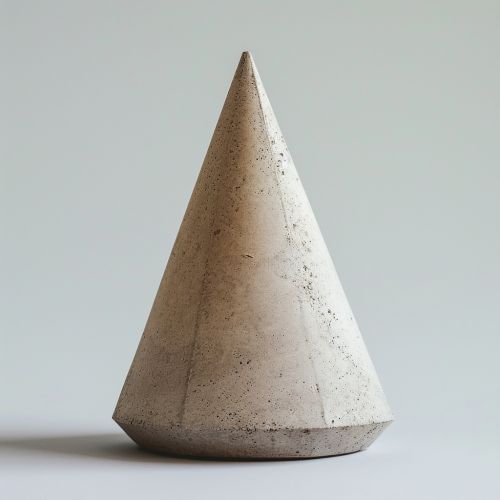Cone (geometry)
Definition and Basic Properties
A cone is a three-dimensional geometric shape that tapers smoothly from a flat, round base to a point called the apex or vertex. A cone is formed by a set of line segments, half-lines, or lines connecting a common point, the apex, to all of the points on a base that is in a plane that does not contain the apex. Depending on the context, "cone" may also mean specifically a convex cone or a projective cone.
The term "cone" derives from the Greek word "kōnos", which means "point" or "pinnacle". In mathematical terms, a cone is a solid or hollow object with a circular or oval base and sides that taper to a point. The base of the cone is called the base, and the point is called the apex.
Mathematical Description
In mathematical terms, a cone can be described by its base radius, height, and slant height. The base radius (r) is the radius of the circular base, the height (h) is the perpendicular distance from the base to the apex, and the slant height (l) is the distance from any point on the circle to the apex.
The volume (V) of a cone can be calculated using the formula V = 1/3πr²h, where r is the radius of the base and h is the height of the cone. The surface area (A) of a cone, not including the base, is A = πrl, where r is the radius of the base and l is the slant height.
Types of Cones
There are several types of cones in geometry, including right circular cones, oblique cones, and elliptical cones.
A right circular cone is a cone in which the axis is perpendicular to the base. The base is a circle, and the axis ends at the apex. This is the most common type of cone and is the one typically referred to when the term "cone" is used without qualification.
An oblique cone is a cone in which the axis is not perpendicular to the base. The base can be any shape, but is typically a circle. The axis ends at the apex.
An elliptical cone is a type of cone in which the base is an ellipse. The axis is a line segment that joins two points on the ellipse and passes through the center of symmetry of the ellipse.
Cones in the Real World
Cones are found in many aspects of the real world. For example, they are used in the design of certain types of loudspeakers, where the cone shape helps to amplify the sound. Cones are also found in nature, such as in the shapes of certain types of pine cones and volcanoes.


